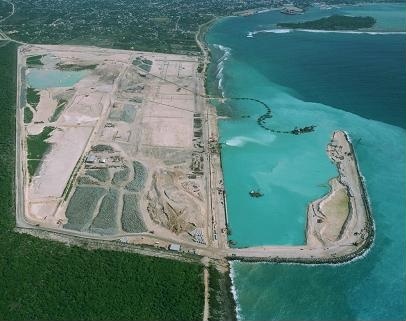Initiation
A new container terminal construction was ordered by CSXWT and constructed by Ballast Nedam Dredging (presently owned by Van Oord). Attention for ecological issues was high from the beginning of the project: the entire board of stakeholders (Dominican Government, financial lenders and project sponsors) ordered an Environmental Impact Assessment Study (conducted by Mouchel Parkman Consulting Services Ltd. Limited). In that way the entire board of stakeholders demonstrated their determination to carry out the works to a high standard of care. Based on the findings of this report and on stakeholders’ requests, the contractors implemented mitigation measures to ensure the ecological safety of the local marine environment.
Pre-feasibility & Feasibility
An Environmental Impact Assessment study has been carried out as part of the project preparation because of the vicinity of a live coral reef and a popular holiday resort at Boca Chica. The EIA study identified various coral colonies that may be affected by the construction works. Adverse impacts on the coral communities were not desirable from an environmental as well as social and economic point of view.
Mitigation measures were recommended for the execution methods to be employed and the incorporation of these measures into the Construction Contract Documents were one of the key conditions for allowing the project to proceed. Also, the water quality and coral was monitored to guide the dredging operations such that no adverse impacts would occur.
The Environmental Study identified certain mitigation measures that should be implemented to avoid possible adverse impacts of the construction works on the marine environment. An Environmental Permit was issued by the Dominican Government following the acceptance of the study and the proposed mitigation measures by SEMARN (The Dominican Environmental Protection Department). This Permit allowed the construction and operation of the project and required the implementation of the mitigation measures and control measures identified by the EISA.
Main areas of ecological concern were nearby located coral reefs and general water quality within the bay of Andres. The bay was a highly important ecological area until the hurricane George in September 1998 caused large destruction of the various coral communities. The coral reefs are still recuperating from this natural disaster. In addition, pollution from sugar processing and waste-water from tourist establishments is affecting water quality which further threatens the health of the coral communities.
Despite these problems the coral reefs are still considered of high ecological value and are frequented by tourists from the Dominican Republic and overseas. In addition, the nearby beaches of Boca Chica are a major recreation area for people from Santo Domingo and tourists.

Location
The location of the project is approximately 1 km south of the existing port of Puerto Andrés and 5 km from the port of Boca Chica. The Caucedo peninsula has been zoned for industrial development and a number of other industrial sites are currently under development.
The site at Cabo Caucedo was chosen as the preferred location for the port. Its proximity to Las Americas International Airport offers the opportunity to develop an intermodal facility and the site is only a 30 minute drive from Santo Domingo. The seabed is also steeply sloping allowing access for large vessels without excessive dredging being required. There is also no requirement for ongoing maintenance dredging.
This project comprised of the construction of a new state of the art container terminal that will function as a container hub for the Caribbean market. Vast marine works were necessary besides the extensive civil works (container stack yard, administrative buildings, container cranes etc.).
The main source of threat to the environment was determined to be the dredging works. These works consisted of:
- Dredging of 2.0 million m3 of coral rock (to form the harbour basin and the entrance channel)
- Reclaiming 1.5 million m3 of dredged material on existing land
- Reclaiming 0.5 million m3 of dredged material behind a breakwater under construction
